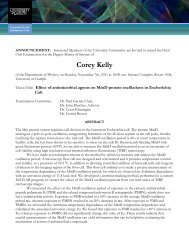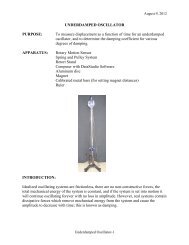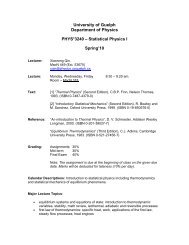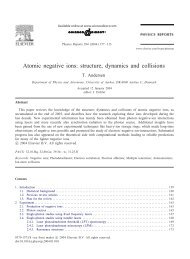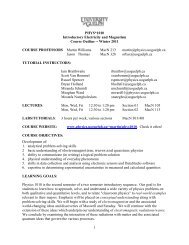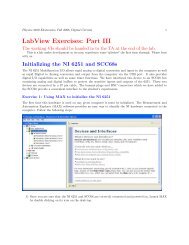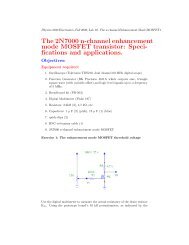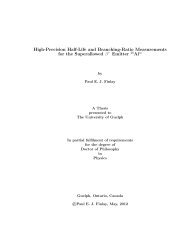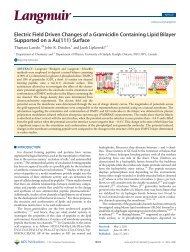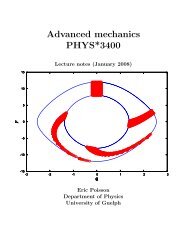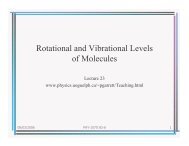Spider Silk: From Soluble Protein to Extraordinary Fiber - Physics
Spider Silk: From Soluble Protein to Extraordinary Fiber - Physics
Spider Silk: From Soluble Protein to Extraordinary Fiber - Physics
You also want an ePaper? Increase the reach of your titles
YUMPU automatically turns print PDFs into web optimized ePapers that Google loves.
Reviews<br />
before the drawdown taper, suggesting that wall shear may<br />
play a role in the transition from liquid dope <strong>to</strong> solid silk;<br />
moreover, controlled flow elongation and water removal<br />
provide an increase in b-sheet structures. [57, 73, 74] In the absence<br />
of salting-out conditions and acidification, elongational flow<br />
did not affect the structural state of the employed silk<br />
proteins, whereas salting-out in the absence of elongational<br />
flow led <strong>to</strong> the formation of spherical aggregates. However, in<br />
the microfluidic device, silk fibers formed only after addition<br />
of phosphate, application of a simultaneous elongational flow,<br />
and a pH change from pH 8 <strong>to</strong> pH 6. [65] It could be shown that<br />
fibers resulted from preformed spherical aggregates that were<br />
forced in<strong>to</strong> contact by the elongational flow in the microfluidic<br />
channel. [65] The resulting fibers were highly flexible,<br />
having structurally highly-ordered regions (mainly b-sheetrich)<br />
along the thread. The surface of the fibers obtained<br />
grainy structures, leading <strong>to</strong> the assumption that the resulting<br />
fibers are still not mature, and in fact most likely represented<br />
an early or intermediate stage of fiber formation. [65]<br />
3.3. A Combined Model for <strong>Spider</strong> <strong>Silk</strong> Assembly<br />
The two models shown in Figure 4 are not mutually<br />
exclusive. The characteristics of the spinning dope as depicted<br />
by these models reflect the physics of liquid crystals, implying<br />
that the micelle formation observed by Jin and Kaplan does<br />
not exclude liquid crystallinity. Lyotropic liquid crystals (i.e.,<br />
liquid crystals that are able <strong>to</strong> undergo phase transitions<br />
dependent on the concentration of its main component) with<br />
amphiphilic character show concentration-dependent selfassembly<br />
behavior in solution: at low concentrations, they<br />
spontaneously assemble in<strong>to</strong> micelles, whereas at higher<br />
concentrations, they are ordered in<strong>to</strong> hexagonal columns. [75]<br />
We propose that this might explain why in-vivo investigations<br />
usually lead <strong>to</strong> the conclusion that the spinning dope displays<br />
liquid-crystalline behavior, whereas in-vitro studies (using<br />
either reconstituted or recombinant silks) give rise <strong>to</strong> a<br />
micellar-like preoriented spinning dope. It should be noted<br />
that native and reconstituted silk dope differ significantly in<br />
their rheological characteristics: native silk dope behaves like<br />
a molten polymer, whereas reconstituted silk dope does<br />
not. [76] Importantly, a higher protein concentration will lead <strong>to</strong><br />
dramatically increased viscosities, enabling fiber formation at<br />
much lower elongational flow rates. [65] These findings indicate<br />
that liquid crystalline behavior of the spinning dope could be<br />
beneficial, but it is definitely not necessary for fiber assembly.<br />
4. <strong>Fiber</strong> Formation: Liquid–Solid Phase Transition<br />
4.1. Phase Transition in the Distal Part of the Spinning Duct<br />
The final step of the spinning process is the transition from<br />
a high-density liquid <strong>to</strong> a solid phase that starts in the distal<br />
part of the duct. [11, 58, 59, 74] As the spinning dope flows through<br />
the spinning duct, a liquid–solid phase transition is initiated<br />
by water removal in a rapid convective process, as described<br />
above, [11, 61] which is contrary <strong>to</strong> the previous postulation that<br />
T. Scheibel et al.<br />
solidification occurs solely upon contact with air. [11, 27, 77–79] A<br />
semi-solid intermediate or premature fiber is moved through<br />
the duct by a pumping mechanism involving the cooperative<br />
work of two muscles, and finally exits through a spigot (often<br />
referred <strong>to</strong> as a valve). [27]<br />
Mechanistic details of the process of moving a semi-solid<br />
spinning dope through a convergent die-like spigot could be<br />
explained by carrying out rheological studies. [80] It was shown<br />
that the force required <strong>to</strong> push the silk dope through the<br />
spigot is 500 times lower than that associated with corresponding<br />
viscous New<strong>to</strong>nian fluids, owing <strong>to</strong> the non-New<strong>to</strong>nian<br />
fluid behavior of the silk dope. [56, 81] Viscous non-<br />
New<strong>to</strong>nian fluids usually show shear-thinning behavior; that<br />
is, with increasing shear force, the viscosity (i.e., the resistance<br />
of the fluid <strong>to</strong> shear forces) of the fluid decreases.<br />
Moreover, the silk dope displays increasing resistance <strong>to</strong><br />
stretching with time and strain imposed during elongational<br />
flow, leading <strong>to</strong> a viscoelastic fluid filament, [80,82] which is not<br />
contradic<strong>to</strong>ry <strong>to</strong> the shear-thinning behavior. The thinning of<br />
the viscoelastic fluid filament (often referred <strong>to</strong> as “necking”)<br />
driven by capillary pressure and resisted by the viscoelastic<br />
stress in the elongating filament, can be best described with<br />
the time-evolutionary necking model. [80,83] In this model, the<br />
thinning/drying process of a viscoelastic filament is based on<br />
the ratio of capillary thinning of the filament and the internal<br />
diffusion of water over time. The resulting necking rate can be<br />
further modulated by accessory evaporation of solvent from<br />
the thread, as the evaporation rate increases with time owing<br />
<strong>to</strong> the increasing ratio of surface area <strong>to</strong> volume. Thus, further<br />
loss of water leads <strong>to</strong> an increase in fluid viscosity and an<br />
additional slowdown in the necking rate. [83] The resistance of a<br />
fluid filament <strong>to</strong> further stretching is characterized by its<br />
extensional viscosity properties, which increase a hundred fold<br />
during capillary thinning. At large strains, the filament undergoes<br />
strain hardening, which inhibits capillary breakup and<br />
finally stabilizes the filament owing <strong>to</strong> the combined action of<br />
molecular elongation and solvent evaporation. Ultimately, a<br />
solid, uniform fiber is formed with constant diameter. [80]<br />
4.2. Final <strong>Fiber</strong> Formation and Control over Mechanical<br />
Properties<br />
The liquid–solid transition is initiated by environmental<br />
conditions, such as partial water removal, elongational flow,<br />
and shear forces (see Section 3.1). The liquid–solid transition<br />
is completed after exiting the spigot, and is caused by the<br />
combination of drawing and loss of water arising from<br />
evaporation in air. Fac<strong>to</strong>rs influencing the evaporation<br />
process include the fiber radius, time of exposure <strong>to</strong> air,<br />
atmospheric humidity and temperature, and the speed of air<br />
flow. [84] However, solvent evaporation is not essential for fiber<br />
formation, as some natural silks are successfully spun in<br />
aqueous environments. [11, 27,77, 78] The drawing and/or stretching<br />
of the fiber from the spigot by the spider leads <strong>to</strong> a<br />
reduction in its diameter (supported by the fact that silks tend<br />
<strong>to</strong> display a moderate, positive Poisson ratio, with a linear<br />
relationship between diameter and extension) resulting in<br />
improved mechanical properties of the fiber. [85]<br />
3592 www.angewandte.org 2009 Wiley-VCH Verlag GmbH & Co. KGaA, Weinheim Angew. Chem. Int. Ed. 2009, 48, 3584 – 3596



